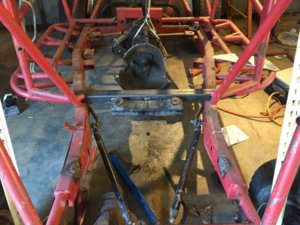Jeremyfc1
Member
- Joined
- Jan 10, 2016
- Location
- Chapel hill nc
ok In a perfect world i.e. No oil pan no steering issues (full hydro). No hanging accessory drives. What style of link suspension would you build. My chassis I am using for my electric buggy was built before I got it. The previous owner mocked up some new upper links as the old ones hit the oil pan. I'm looking to reuse the original link location but if I'm ordering links and playing with it already maybe I'll change it up. As it currently stands I'm not sure the front driveshaft will clear the upper link. And I have to get everything mounted before I have a shaft made and it would suck if the driveshaft interferes with the upper link
Pic is before I went to dual cases and did away with the trans. But shows the temp upper link location
Pic is before I went to dual cases and did away with the trans. But shows the temp upper link location


